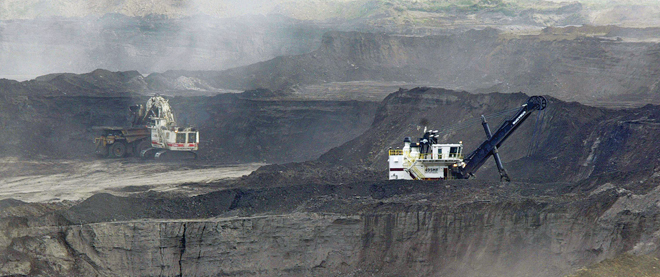The museum is the message
A federal science museum offers a polished image of the oil sands
Jeff McIntosh/AP
Share

A huge tire from one of the giant mining trucks that rumble around Alberta’s oil sands is not on display outside the Canada Science and Technology Museum to draw attention to its current exhibition, “Energy: Power to Choose.” That’s disappointing to Denise Amyot, president of the federal museum’s parent corporation, who wrote in an email last spring that she thought an outsized tire “would have been a big hit!” But some oil industry officials didn’t like the idea, according to Amyot’s note, so it was dropped. And quashing the tire gimmick was just one example from documents obtained by Maclean’s under the Access to Information Act of what appears to have been pervasive influence from the energy sector in shaping the exhibition’s content.
The show, which opened last July, is the cornerstone of a six-year project by the museum called “Let’s Talk Energy,” which includes a website, classroom materials, and a plan to tour the exhibition across Canada. The Imperial Oil Foundation and Encana Corp., two fossil fuels heavyweights, are its major sponsors. In a document sent to potential sponsors, the Canada Science and Technology Museums Corporation pitched the advantages of supporting the project this way: “Your story will be part of a balanced approach, bringing information and perspective to the public that cannot be delivered through the filters of the mainstream media.” For this “enhanced communications” opportunity, major sponsors were asked for $100,000 a year for six years.
The show includes informative displays on consumption and conservation, wind and solar power, hydro and nuclear. But it’s easy to see why the oil sector in particular might find it appealing. For instance, in an email to Daniel Bourdeau, the museum corporation’s director of sponsorship sales, an “exhibition interpretation officer” working on developing the show last year wrote: “I think this is a ‘good news’ oil sand story that we would like to tell, but we really need the assistance of [the Canadian Association of Petroleum Producers], the Govt. of Alberta, or one of the oil companies.”
CAPP did eventually sign on as a sponsor, although at a more modest level than the Imperial Oil Foundation and Encana. The Calgary-based industry group also served on an advisory committee created by the museum, made up largely of industry representatives, along with some government officials, academics and consultants. Sponsors and advisory committee members were invited to review and comment on the show’s content.
CAPP president David Collyer made many precise suggestions. In an email last spring, he urged more emphasis on the oil sector’s importance to the Canadian economy, especially exports. “We agree with your comments regarding the energy economy section,” replied Luc Fournier, the museum’s corporate communications director. Of the show’s oil sands display, Collyer said “imagery of a mining truck is problematic.” Instead of focusing on mining—the sort of photographs often used by environmental groups to draw attention to the impact of the mind-bogglingly massive development on Alberta’s boreal forest—Collyer suggested an emphasis on drilling methods for extracting oil by injecting steam deep into the ground. “We have shifted the focus,” Fournier responded, “more towards drilling but still mention mining.”
Sure enough, the final version of the backlit oil sands display features a small photograph of a mining operation, but several larger illustrations of the drilling techniques Collyer mentioned. “Canadian oil sands are an important global resource,” reads the display text, “making Canada a powerful and influential world leader in the energy field.” A point-form list of environmental and other issues is presented under the reassuring line, “The oil sands industry takes these challenges very seriously and is working to find solutions.” Global warming is alluded to only briefly: “Canada’s oil sands projects account for one-tenth of one per cent of global greenhouse gas emissions.”
Collyer said in an interview that CAPP “tried to present a balanced suite of information.” “Ultimately,” he noted, “the curators at the museum have to decide what is the right mix of information to display.” Indeed, in a written response to questions, the museum said that while sponsors might see “their stories reflected in exhibitions,” they are not allowed to “convey any ‘policy’ messages,” and added it won’t allow “sponsors or any other institutions to have the final say in the content of its exhibitions.”